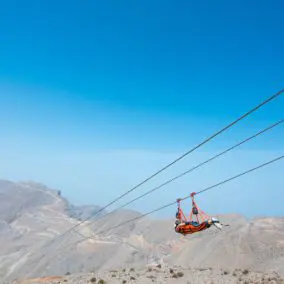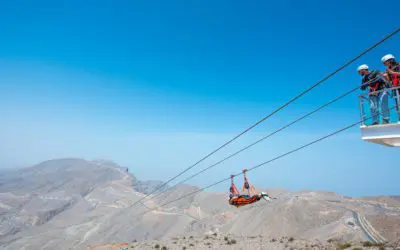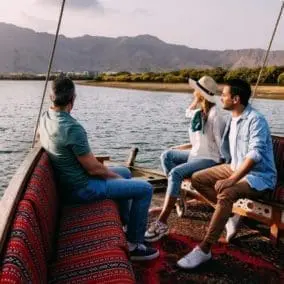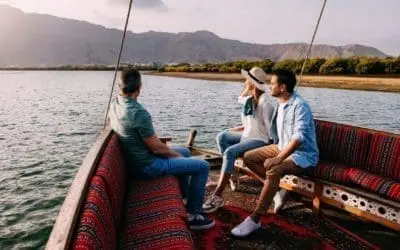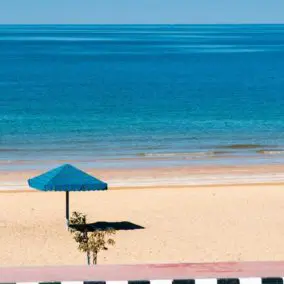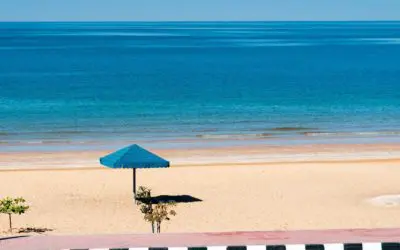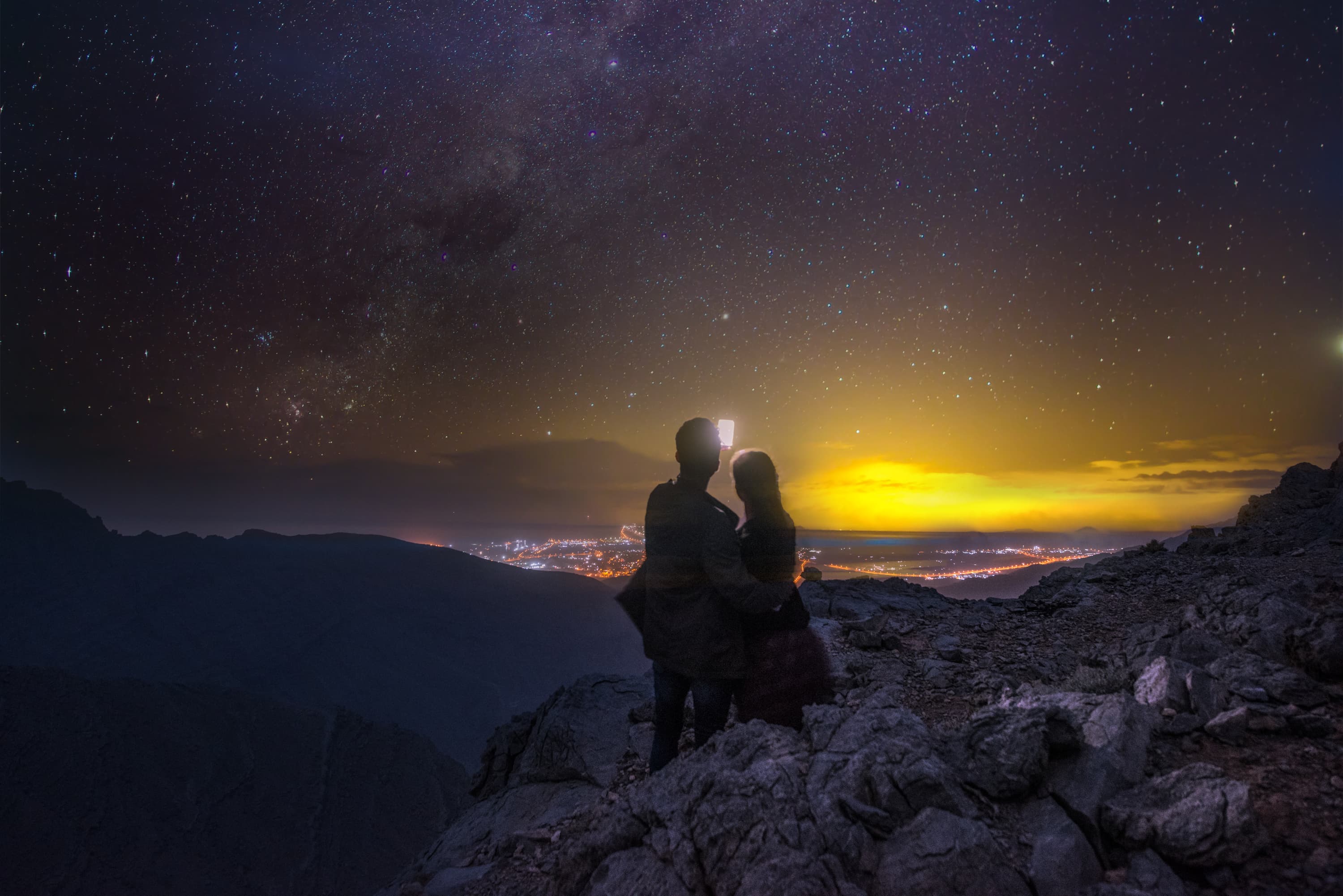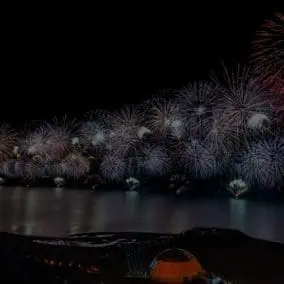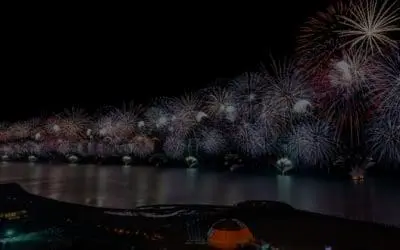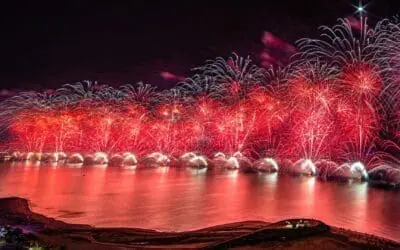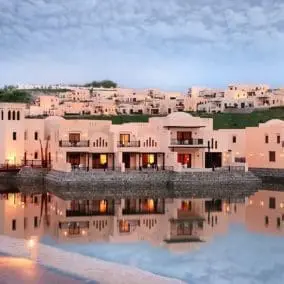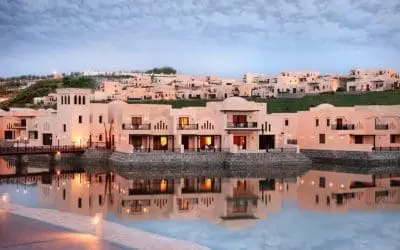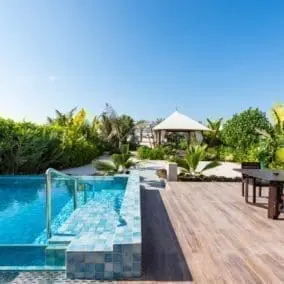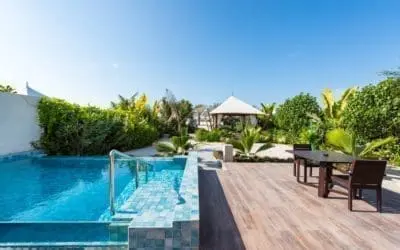Ras Al Khaimah is an Emirate like no other. The northernmost Emirate boasts spectacular topography, distinct landscapes, ancient traditions, abundant nature and many warm, friendly welcomes. Its diversity makes it one of the most exciting places in the Middle East to explore. The following guide gives you an insight into some of the most extraordinary travel experiences and places of interest imaginable.
Camel Racing
Camel racing is mesmerising. If you’ve never experienced camel racing before, it should simply be a must-do on your bucket list. The races take place early on a Friday morning in the cooler winter months. Glorious dunes and straggly ghaff trees pepper the landscape around the Digdaga and Hamraniya area of Ras Al Khaimah and the expansive race track. There are usually around 100 camels waiting for their call to race. The camel races start early at 06.30 before the sun gets too hot. It’s worth arriving at the track early to experience the electric anticipation of the trainers and owners as they battle for the winning trophy, luxury cars and monetary compensation that can add up to millions of dirhams.
Each dromedary is saddled with colourful tribal blankets and walks silently through the dust-filled deserts. At dawn each day, you’ll find trainers trotting up and down the tracks building the camel’s stamina for the big Friday race. The sun at this time of day is very low and casts elongated shadows over the dunes.
The UAE prohibited human jockeys under 15 years from competing in camel races almost two decades ago. 2002 saw the introduction of lightweight robot jockeys with mannequin-like faces, sunglasses, traditional racing silks and a hat. The electronic jockey monitors the camel’s heart rate and running speed and is enhanced with a two-way radio so that the owner or trainer can encourage the camel with familiar commands.
Camel Racing
Jebel Jais Mountains
The Jebel Jais Mountains form the highest peak in Ras Al Khaimah and soar 1,934 metres above sea level. The mountain has exciting topology and contains endless rare fossils and terrestrial sedimentary and marine rocks, giving a fascinating insight into ancient times. Scientists believe the Al Hajar Mountains were formed by a continental collision at the Arabian–Eurasian convergent plate boundary more than 70 million years ago. The name Al Hajar translates into ‘Al’, which means ‘the’, and ‘Hajar’, which means ‘stone’; when the words are combined, the name translates into ‘The Stone’.
The mountains are home to playful mountain goats, shy foxes, and wild felines. The Arabian leopard could also reside in the mountains. Sightings are so rare that none have been recorded since the turn of the century and the leopards are on the Critically Endangered IUCN Red List.
At the foot of the mountains are the wadis, an Arabic word for valleys. Any nature tends to lie dormant during the warm summer and waits patiently for the rains. When the rains appear, the wadis fill with water and become busy watering holes for goats, camels, and the occasional lonesome donkey. The low-lying lands turn into lush flowering meadows which attract birds, bees, butterflies and other nectar-feeding insects. If you are lucky enough to witness the rains, you’ll find plant life such as plantago ovato, a hairy plant with tiny off-white flowers, the blue-scarlet pimpernel, desert cotton, sorrel and the pretty morning blooming convolvulus virgatus. Rare plants happily bloom for a week or two before disappearing again. These lush landscapes happen rarely, but when they do, they magically turn the mountains into a spectacular location for hiking, camping and exploring.
Jebel Jais Mountains
Dhayah Fort
Dhayah Fort is an impressive castle-like spectacle in the centre of a lush oasis, boasting 360-degree views from the mountains across ancient date palm trees and down to the Arabian Gulf. Dhayah Fort is the only remaining hill fort in the United Arab Emirates and dates back to the Late Bronze Age, when locals used it for settlement and fortification. It’s undoubtedly worth climbing the 100-zigzagging steps to take in the spectacular views.
The fort is on the UNESCO World Heritage Tentative List and stands proud amidst the arid mountains and the fertile date wadis. It is a crucial UAE historical monument where the 1819 battle between British troops and local Qawasim tribes took place.
The 1812 battle was the last in Ras Al Khaimah. British troops initially could not reach the fort by foot or with canon fire because of its height and steep flanks. Eventually, the determined British invaders moved their most powerful canon from their ship, across the sandy bays and through muddy mangroves. Two shots finally forced the local tribes to surrender.
Single watchtowers are dotted throughout the fertile oasis of Dhayah to ensure optimal defence and communication. At the foot of the hill lies a slightly larger fort used by people who lived and worked in the palm gardens or farms. At times of danger, they would retreat here with their animals.
Dhayah Fort
Al Rams
You’ll find the old fishing village of Al Rams near the border of Oman. The slightly down-at-heel fishing village is home to the early Tanaij tribe, who were once traders, fishermen, pearlers, and mountain men. They lived in simple homes built from seashells, coral, and acacia wood. If you explore the village, you’ll see stone houses that were once occupied by the wealthy. The village’s shoreline is shallow and calm and reflects 70 million years of mountainous history in its waters.
Now and again, a pink lake appears, a phenomenon known as a sabkh. The coastal sandflat accumulates saline minerals due to the evaporation of trapped seawater and the arid climate. As a result, the lake’s salinity levels are higher than usual and cause red algae to feed on magnesium-rich nutrients. This bloom is short-lived and vanishes when the algae consume all of the water’s nutrients and die off, or the tide rises and washes it back to the sea.
Nature lovers appreciate the lengthy Rams Beach and Saraya Island. The pristine waters are shallow, calm, and perfect for peaceful watersports like kayaking and paddle boarding. You’ll be able to marvel at wild camels taking themselves for an early morning swim to rid themselves of the desert sand and pesky bugs. There is a horse stable on the island. So why not take a leisurely walk on horseback through the warm shallows or thunder along the beach in full gallop.
Al Rams
Al Jazirah Al Hamra
Al Jazirah Al Hamra is another unique offering you can’t find anywhere else in the United Arab Emirates. The village was once a tidal island split into two sections. The Zaab tribe maintained a fleet of 25 pearling boats and tended some 500 sheep and 150 cattle until the crash of the pearl fishing industry in the 1920s. The village is on the UNESCO World Heritage Cultural Tentative List; it represents thousands of years of classic social strata architecture and town planning in the Middle East.
Archaeologists have recorded the discovery of the 20-domed Al Jazirah Al Hamra’s ancient mosque, pictured on an 1820s British map. Narrow alleyways connect houses to the souq and the village mosque. Architects combined plain and ornamental archways, elaborate plaster screens and other time-sensitive decorative elements throughout the village. The wind tower residence has a fine example of the windcatcher or barjeel, a passive ventilation and cooling system.
It’s thought the inhabitants left the village between 1968 and 1971 upon discovering oil and its related wealth. Many buildings are in ruin or disrepair, so precaution is advised. Various art-inspired events are held throughout the year.
Al Jazirah Al Hamra
Ras Al Khaimah Desert
The terracotta Ras Al Khaimah desert is quite simply spectacular. It ranges from eerie moonscapes to captivating ever-moving silent dunes. In 3000BC, the Bedouins lived in the desert and celebrated their nomadic lifestyle; today, they still practice their hauntingly beautiful age-old rituals. For hundreds of years, Bedouin families seasonally moved around the region in search of a cooler climate, water and agricultural land for their camels and goats. Ras Al Khaimah has a unique climate and the rainfall in the cooler months leaves the desert lands fertile. The winter months display abundant native quiescent plants as desert ephemerals and hyacinths blossom and flourish.
If you possess a sense of adventure, a range of adrenaline-pumping activities takes you to the heart of the desert. Head to a desert camp for a day exploring the dunes in a luxury 4X4 Landcruiser, dune buggy, or a quad bike. At the Bedouin-inspired camps, you can learn more about their age-old traditions. Regale stories of your own 1001 Arabian Nights adventures, and enjoy a night under twinkling stars around a crackling campfire. As the sun sets, enjoy traditionally prepared food, dancing and merriment. You can even have an exquisitely drawn henna tattoo penned by a local Bedu woman.
Throughout the year, you can attend various festivals celebrating the Bedouin culture and the history of Ras Al Khaimah. You can experience Al Wahabiyya, a traditional stick dance unique to Ras Al Khaimah, the lythe movements of the belly and tanoura dancers and Taghrouda, an exquisite form of Bedouin poetry and mesmeric chanting.
Desert
Kayak through the Ras Al Khaimah mangroves
Ras Al Khaimah has an impressive 65 kilometres of coastline, much of which is the bird and fish-filled mangroves. Once scorned as swampy wastelands, the mangroves are now valued for providing the shorelines with a diverse and safe ecosystem. Paddling through the inner city mangroves is a unique experience, with the juxtaposition of nature and manmade structures uniting to offer the best of both worlds. The mangroves are serene, and there is no better way to explore than aboard a kayak or paddle board.
Mangroves are highly recognisable from their visible root systems, giving them the strange impression of being planted upside-down. The densely populated trees provide a safe nursery environment for thousands of fish, molluscs and crustaceans seeking refuge from their larger predators. The Ras Al Khaimah mangroves are home to bubblegum pink flamingoes who spend their days feasting on algae and crustaceans, shrimp and plankton. The mangroves are also home to the Kalba collared kingfisher, western reef heron and the greater spotted eagle.
Kayak through the mangroves
Fly over Ras Al Khaimah
Imagine experiencing a bird’s eye view as you traverse the skies above Ras Al Khaimah. Board a gyrocopter or a two-seater plane with your captain and fly over the terracotta dunes that are synonymous with Ras Al Khaimah. You’ll see the various landscapes that the Emirate has to offer, from the pretty Al Hamra village with its manicured gardens, golf course and iconic Waldorf Astoria to the coral-inspired artificial islands of Al Marjan, Breeze, Treasure, Dream and View; each with its own lagoons, beaches and promenades. The Al Jazirah Aviation Club is based on the outskirts of Al Hamra Village.
Heading north, you’ll fly over Mina Al Arab, the marina-inspired development, as you head to the city with its bustling ports, busy markets, and shopping malls. Take a moment to notice all the mosques, particularly the Mohammed Bin Salem Mosque, a modest Ottoman-inspired place of worship built from ancient coral blocks in the 1900s. Enjoy the flamingo-filled mangroves as you head toward the towering Jebel Jais mountains, where you’ll glimpse the world’s longest zip-line, careering toboggans, hikers and perhaps a lonely mountain goat.
Al Jazirah Aviation Club
Suwaidi Pearls
Abdulla Al Suwaidi opened the eponymous Suwaidi Pearl Farm in honour of his late grandfather, Mohammed. Archaeologists discovered that the Ras Al Khaimah pearl industry was thriving in the 12th century and became one of the most bustling trading ports in the region. Pearl fishing is still celebrated as one of the United Arab Emirates’ treasured traditions. Take a step back into a world where entire communities of men would dive for exotic pearls.
Suwaidi is endlessly passionate and proud that he is working to revive this almost-extinct tradition. He has an inherent understanding of the pearl fishing industry and its importance in Emirati culture. There are many folkloric myths and magical legends surrounding these beautiful gemstones. Visitors can explore the fisherman’s history with the ocean, the pearls, and how Ras Al Khaimah is referred to as ‘the pearl of the Emirates’.
You can embark on a fascinating journey aboard a traditional pearl fishing boat. From the pontoon in the original fishing village in Al Rams, your tour will begin as Abdulla or your guide explains the importance of the shallow waters and their protective mangroves. Next, you will discover the innovative scientific techniques used in modern-day pearl farming and explore The Suwaidi Pearl farmhouse.
Suwaidi Pearls
Kuwaiti Souq
Souqs are at the heart of any community across the Middle East, and none more so than the Kuwaiti Souq. By exploring the traditional markets, you’ll soon learn how to shop the local way; it’s not for the faint-hearted! Prices are impulsive, so it’s a great place to hone your bargaining skills; shopkeepers expect you to try and haggle. Before you get started, set yourself up with a strong coffee made with dark, bitter beans that are ‘cooked’, served black and sweetened with cardamon or condensed milk.
At the market, you’ll find everything from herbs and spices, mops, alarm clocks and other household goods, yellow and rose gold, souvenirs, synthetic fabrics and pashminas, colourful camel sculptures and arty nik-naks and trinkets. The best time to visit the souq is in the early morning or late afternoon, where you can join the busy streets and hunt out a bargain or two. The market and its narrow streets have a slightly timeworn feel. Pop into the local tailoring shops and discover over 50 hues of white fabric that tailors handcraft into crisp white kanduras for Emirati men, whilst the hundreds of bolts of black fabric will become abayas, the traditional dress for Emirati ladies.
Round off your day with a fancy Arabian-inspired ice cream from Ashuk, a favourite local café. Or try the humble shawarma, a flatbread wrap full of succulent, gently spiced meat perfectly cooked on a rotating skewer, served with vegetables and pickles and bound with nutty tahini.
Kuwaiti Souq




